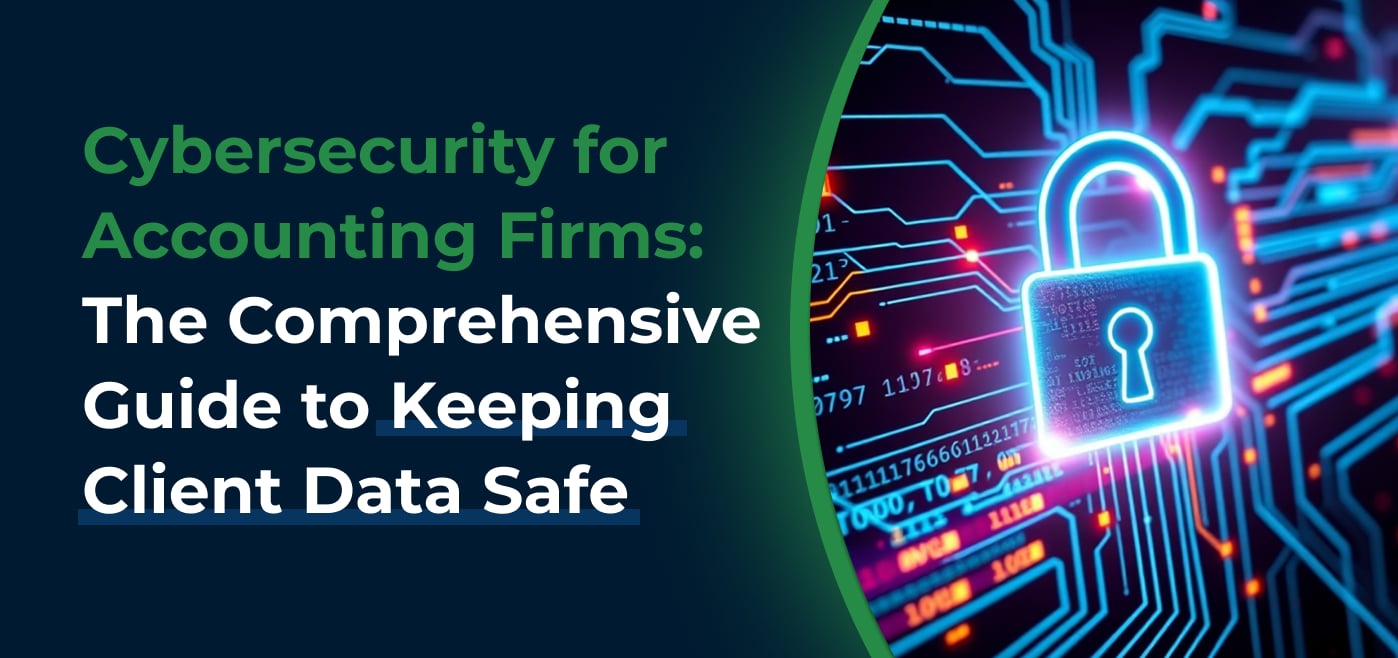From Social Security numbers to tax IDs and payroll files, accounting firms manage some of the most valuable data around. And that makes them prime targets for cybercriminals.
Since 2020, reported attacks on accounting practices have jumped 300% according to Today’s CPA, and a Georgia CPA firm recently paid a $450,000 ransom just to regain access to encrypted files. Even worse, across all financial-services breaches, the average incident now costs $6.08 million, 22% above the global mean, according to IBM’s Cost of a Data Breach 2024 report.
Add reputational damage, regulatory fines, and lost clients, and it’s clear that cybersecurity for accountants is more important than ever. It’s a prerequisite for client trust, compliance, and the basic continuity of your practice.
In this guide, we’ll share all you need to know about keeping clients’ data safe.
Why Cybersecurity Is Critical for Accountants
Every accounting and bookkeeping firm must take cybersecurity seriously today. “We can’t just sit back and say, ‘I don’t understand this’ or ‘I’m going to plead ignorance.’ Ignorance is no longer an excuse,” says Brad Messner, cybersecurity expert and seasoned tax professional. This is because of several reasons like:
Accountants Handle Highly Sensitive Data
Accounting firms store data that can be used for identity theft, tax fraud, and financial account takeovers. So when a breach occurs, it’s a direct threat to your clients’ financial lives.
A single exposed record might include a Social Security number, income history, bank account details, or even login credentials. That’s more than enough for criminals to file fraudulent tax returns, open credit lines, or drain accounts.
You Have a Legal and Ethical Responsibility To Protect Client Data
As a financial professional, safeguarding client information is a legal requirement and an ethical obligation.
Under the FTC Safeguards Rule, which applies to tax preparers and many small firms, you’re required to implement a Written Information Security Plan (WISP), encrypt sensitive data, and monitor access to client information. The 2023 update introduced nine mandatory security controls, and failure to comply can result in fines of $100,000 per incident plus $43,000 per day until the issue is resolved.
You’re also subject to IRS Publication 4557, which outlines strict requirements for protecting taxpayer data. This includes secure storage of records, proper disposal, and the use of encrypted, secure systems for sending returns.
Failure to follow these regulations can lead to fines, audits, and in extreme cases, suspension of your PTIN or EFIN.
Data Breaches Can Cause Reputational Damage and Trigger Potential Lawsuits
Your clients trust you with their most private financial information. That trust is hard-earned and easily lost. But a breach can result in loss of clients, damage to your reputation, and lawsuits for negligence or failure to protect data.
Case in point: Chicago-based Legacy Professionals LLP had to notify 216,752 individuals after a 2024 hack and is already facing at least five class-action lawsuits over the exposed data.
In today’s competitive market, most clients won’t return after a breach, and prospective clients may think twice.
Cybersecurity Is a Compliance Issue
Whether you’re a solo practitioner or a multi-partner firm, cybersecurity is a regulatory requirement. U.S. accountants and tax professionals must comply with several federal and state rules that govern how client data is protected like:
- FTC Safeguards Rule: Requires firms to implement security controls and regularly assess risks. Also, firms must notify the FTC of a breach within 30 days if a breach affects ≥ 500 consumers.
- IRS e-File regulations: Expects tax preparers to use secure data storage and transmission methods.
- State data privacy laws: Many states now require immediate breach notification and impose penalties for lax data handling.
What are the Top Cybersecurity Threats Facing Accounting Firms?
Accounting firms face a unique set of cybersecurity risks because of the volume and sensitivity of the data they manage. And with more firms operating remotely or using cloud-based tools, the attack surface is larger than ever.
Here are the most common cybersecurity threats targeting accounting firms today, so you know exactly what to look out for and how to protect against them.
1. Phishing and Email Scams
Phishing remains the #1 attack vector across industries, and accounting firms are high on the list due to the sensitive data they handle. The 2025 Verizon DBIR shares that 60% of breaches involve “the human element,” i.e., users clicking links, replying to spoofed messages, or missending data.
In these scams, attackers impersonate vendors, clients, or even firm partners to trick employees into clicking malicious links or handing over credentials.
Phishing is dangerous because many such emails look like legitimate QuickBooks, DocuSign, or IRS notices, but clicking them can install malware, steal credentials, or redirect you to a fake login page and give attackers access to your client files and systems.
2. Ransomware Attacks
Ransomware attacks encrypt your files and demand payment to restore access. This can be devastating for small-to-mid-sized firms, especially as the average ransom demand for an accounting firm is now north of $300,000. Multiply that by write-offs for missed filing deadlines and remediation costs, and a single incident can erase a year’s profit. And in many cases, even paying the ransom doesn’t guarantee full file recovery, which can paralyze your entire firm for days or weeks.
3. Insider Threats (Intentional or Accidental)
Insiders like partners, staff, or contractors can cause or enable more security breaches than you would think. 83 % of organisations recorded at least one insider incident in 2024, and the share experiencing 11-20 insider incidents quintupled from 4% in 2023 to 21% in 2024.
Most of the time, these attacks aren’t intentional. It happens when someone forwards a client spreadsheet to the wrong Gmail address or keeps a copy on an unencrypted USB stick. “A data breach doesn’t always involve a malicious hacker from abroad trying to infiltrate a firm. It can simply be a mistake, like accidentally emailing the wrong document or uploading the wrong file to a client’s folder. It means that information was shared with an individual who was not authorized to see it, and it happens very frequently,” says Brad. However, sometimes a disgruntled ex-employee with active login credentials could delete or leak client data.
Insider threats are often harder to detect because they often use legitimate access, which is why they are so dangerous.
4. Weak or Reused Passwords
Despite growing threats, many firms still use weak passwords like “Spring2024!” or reuse the same login across multiple tools. These practices make it easy for attackers to break in using brute-force tactics or credential-stuffing attacks.
According to the 2025 Verizon Data Breach Investigations Report, 88% of attacks on web applications involved stolen or brute-forced credentials. Even worse, only 3% of leaked passwords met basic complexity standards. With over 2.8 billion passwords exposed and posted for sale in 2024 alone, a single reused login could give attackers access to every cloud tool your firm depends on, from tax software to document storage.
To stay secure, firms must enforce strong, unique passwords and implement multi-factor authentication across all systems.
5. Insecure File Sharing or Client Portal
Many small firms still send sensitive client information via email or generic cloud storage links (e.g., Google Drive without access controls). These are easily intercepted, forwarded, or accessed on compromised devices. That’s because most of these methods lack proper encryption, expiration controls, or detailed access logs, making it impossible to track who accessed what and when. A misplaced link or unauthorized access can expose tax returns, payroll reports, or bank details without the firm ever knowing.
5. Lack of Data Encryption or Backups
Your firm’s data should be encrypted both at rest (on devices, servers, and cloud storage) and in transit (as it moves between users or systems). Without proper encryption, a lost laptop or compromised account could expose every client file in plain text, making it easy for attackers to steal or sell sensitive information.
Backups, meanwhile, are your safety net. They allow you to recover from system failures, accidental deletions, or ransomware attacks. In simple terms: encryption protects live data, backups protect your ability to recover.
Yet many firms fall short on both fronts. Some store unencrypted data on devices, others rely on basic “sync folders” without real backup policies. Cybercriminals know this, as modern ransomware often targets and corrupts local backups first. Firms without secure, offsite copies are left with two bad options: pay the ransom or lose their data entirely.
Cybersecurity Best Practices for Accounting Firms
Here are some best practices to keep in mind to ensure proper cybersecurity in your firm.
Use Secure Client Portals for File Sharing and Messaging
Email doesn’t offer enough protection for sensitive files like tax returns, financial statements, or payroll reports. Attackers can intercept attachments, and staff or clients can easily misdirect or forward them without realizing the risk.
Instead, use a secure accounting client portal to share and collect documents. These portals encrypt files, control access, and keep everything organized. Clients can upload files directly, and you decide who on your team can view or download them.
Financial Cents’ client portal, for example, gives you:
- Two-factor authentication to block unauthorized access
- AES-256 and AES-128 encryption to protect all stored files
- Message Authentication Code (MAC) to prevent files from being modified once encrypted
Have a Written Information Security Plan (WISP)
Create and maintain a WISP for your firm. This outlines your firm’s policies for protecting client data, handling breaches, assigning roles, and training staff. Firms without a documented plan risk fines, legal actions from customers.
Require Strong, Unique Passwords and Multi-Factor Authentication (MFA)
Weak or reused passwords are a top vulnerability. Use passphrases that are at least 14 characters long, and make sure every account has a unique login (no reuses).
Also, switch on MFA in every cloud app. It adds a second layer of protection, even if a password is compromised. MFA can block 99.2% of account compromise attacks according to Microsoft.
Regularly Update Software and Systems
Outdated software contains known vulnerabilities that hackers can exploit easily. This includes your operating system, tax prep software, browser extensions, and plugins.
Enable automatic updates and check at least monthly that:
- Your antivirus definitions are current
- Your OS patches are installed
- All critical software (QuickBooks, tax tools, CRM) is on the latest version
Train Staff on Identifying Phishing Attempts
Your tools are only as strong as the people using them. Conduct ongoing training to help staff recognize fake IRS or vendor emails, spot suspicious links or attachments, and avoid sharing passwords or clicking prompts from unknown sources
Additionally, run phishing simulations regularly and make security training part of your onboarding and quarterly check-ins.
Encrypt Data at Rest and in Transit
The Safeguards Rule explicitly requires encryption “on your system and when it’s in transit.” This ensures that even if data is stolen, it can’t be read without the proper decryption key.
Enable full-disk encryption on every laptop and server for data at rest. For data in transit, enforce TLS encryption (HTTPS) for file sharing, email portals, and cloud platforms
Choose vendors and tools that offer AES-256 encryption and display their compliance certifications (e.g., SOC 2) like Financial Cents.
Implement Role-Based Access Controls
Every team member should only have access to the data and systems they need to do their job. Overly broad access increases the risk of accidental exposure or insider threats.
Use role-based access controls to restrict junior staff from seeing client tax history or billing info, prevent terminated employees from accessing systems, and log access history for auditing. Map each job role to the minimal set of client folders and revoke dormant accounts every 90 days.
Schedule Regular Data Backups and Test Restores
Backups are essential for recovering from ransomware, accidental deletion, or system failure. But a backup is only useful if you can restore it. So, back up data daily to an encrypted offsite/cloud location, use versioning to roll back if infected, and test restore capability at least twice a year.
Also, ensure backups cover client documents, email, CRM data, and accounting software files.
Use Antivirus and Firewall Protections
Install reputable antivirus software on every device (including staff laptops). Ensure real-time scanning is active and definitions are updated daily.
A firewall blocks unauthorized incoming or outgoing traffic which is especially important for remote or hybrid teams accessing your systems over public networks.
Limit Use of Personal Devices for Work
Allowing employees to access firm systems or download client files on personal devices creates a serious risk. These devices are often unsecured, unmonitored, and shared with others.
Instead, provide firm-owned, managed devices with company-controlled software or require mobile-device-management (MDM) enrollment for phones and tablets before staff can access client data.
Monitor for Suspicious Activity or Access Logs
Financial institutions still need 168 days on average to spot a breach, but continuous log monitoring and alerting can shorten that window. Most cloud apps offer access logs and alert settings that allow you track logins from unusual locations or IP addresses, multiple failed login attempts, file downloads outside normal hours, etc.
Review these logs weekly or automate alerts using a security dashboard or managed service provider (MSP) such as Verito, and investigate anomalies ASAP.
How Practice Management Software Helps Improve Cybersecurity
Brad advises firms to invest in high-quality software to strengthen their security foundation. “Invest in the right security tools and technology. Don’t settle for cheap, low-end options. Choose the tools that best fit your firm’s specific needs,” he says.
A good practice management software helps improve cybersecurity for accountants by offering the following functions:
Centralized Control and Audit Trails
With an accounting practice management system, all client communications, files, and internal activity live in one secure system, instead of being scattered across inboxes, spreadsheets, or personal devices. This centralization makes it easier to enforce security policies, manage access, and maintain full visibility.
Secure Client Communication and File Sharing
Practice management tools usually include built-in secure portals where clients can upload and download documents safely, send messages, and get notifications, all protected by end-to-end encryption and two-factor authentication.
See this review of the best secure-file sharing tools for accountants.
Controlled Staff Access and Task Visibility
Practice management software often offer role-based access control to ensure that team members only see what’s relevant to their role. This minimizes the risk of accidental data exposure and prevents unauthorized access to sensitive information.
Automatic Backups and Activity Logs
If your system goes down due to a breach, hardware failure, or ransomware attack, backups are your safety net. But many firms don’t have consistent or tested backups in place, leaving them vulnerable to permanent data loss.
Practice management software helps with this by automating daily backups and storing them securely off-site, often with version history to support easy recovery.
Financial Cents Is Built With Your Firm’s Security in Mind
“One of the reasons why I love Financial Cents is they make security so easy you don’t even recognize that they’re applying it behind the scenes at every step,” Brad says.
If you use Financial Cents to manage your firm’s operations, you don’t have to worry about common cyber threats like unsecured file sharing, accidental data exposure, or unauthorized staff access. Our tool is built with accounting security in mind and helps you stay compliant and protected without adding extra work to your day.
Here’s how Financial Cents keeps your firm secure:
- SOC2 and PCI-DSS compliant infrastructure with secure cloud hosting
- AES-256 and AES-128 encryption for all data at rest and in transit
- Role-based access controls so staff only see what they need
- Secure client portal for file sharing and communication
- Expiring, encrypted magic-link technology, so clients can log in without needing to remember usernames or passwords
- Email audit trail that shows every email sent to or received from a client, along with who sent it and when
Security is baked into every part of the platform, so you can focus on growing and managing your firm while knowing your client data is protected.
Use Financial Cents to manage your accounting firm.






